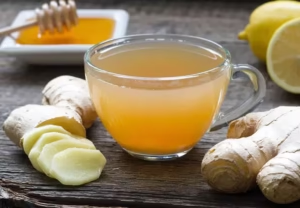Introduction to Natural Remedies
In recent years, the interest in natural remedies has surged, as more individuals are seeking alternatives to conventional over-the-counter medications. This increasing popularity can be attributed to a growing awareness of the advantages that natural ingredients offer, including fewer side effects and a holistic approach to health. Many people are turning to their kitchens for solutions, uncovering a treasure trove of remedies that can address common ailments and promote overall well-being.
Natural remedies often utilize everyday items found in kitchens, such as herbs, spices, and other culinary staples, making them accessible and convenient for many. For instance, garlic, turmeric, ginger, and honey are known not only for their culinary uses but also for their health benefits. These ingredients can help alleviate inflammation, boost the immune system, and even serve as natural antimicrobials. The versatility of these kitchen staples is a testament to the potential of natural solutions for maintaining health.
This holistic approach to well-being emphasizes the importance of treating the body as a whole, rather than merely addressing symptoms with pharmaceutical options. Embracing the concept of natural remedies encourages individuals to explore the healing powers of food and its components. Additionally, the integration of natural remedies can foster a greater awareness of nutrition and personal health in daily life.
Furthermore, using natural remedies can empower individuals to take control of their health and make informed decisions regarding their wellness. By utilizing kitchen staples, people can create simple but effective solutions that contribute to better health. The following sections will explore ten accessible natural remedies that truly highlight the potential benefits of ingredients typically found within one’s kitchen, paving the way for a more sustainable and health-conscious lifestyle.
Honey: The Sweet Healer
Honey has been revered for its medicinal properties for centuries, often referred to as “nature’s sweet healer.” This golden liquid possesses a variety of beneficial attributes, including antimicrobial, anti-inflammatory, and antioxidant effects, making it an invaluable addition to any home remedy arsenal. The antimicrobial properties of honey are largely attributed to its low moisture content and high acidity, which create an inhospitable environment for bacteria and fungi. As a result, honey can be used as a natural remedy for treating wounds and minor burns, promoting faster healing and reducing the risk of infection.
Beyond its wound-healing abilities, honey is an effective soothing agent for sore throats and coughs. By coating the throat and providing relief from irritation, honey can help alleviate symptoms associated with colds and other respiratory ailments. It is often recommended to mix honey with warm water or herbal teas for enhanced benefits. This not only soothes the throat but also offers additional hydration.
When it comes to selecting honey, it is crucial to opt for the highest quality available. Raw, unprocessed honey is considered the best choice as it retains its natural enzymes, nutrients, and health benefits. Look for honey that is labeled as “raw” and “unfiltered,” ensuring that it is free from additives and preservatives. To incorporate honey into your daily routine, consider adding it to your morning oatmeal, using it as a natural sweetener in beverages, or even applying it topically to minor cuts and burns. By integrating honey into your life, you can harness its impressive health properties while enjoying its delightful taste.
Ginger: The Spice of Health
Ginger, scientifically known as Zingiber officinale, is renowned not only as a flavorful spice but also as a powerful natural remedy found in many kitchens. Its medicinal properties have been utilized for centuries, primarily for its effectiveness in aiding digestion, reducing nausea, and alleviating muscle pain. The health benefits of ginger are rooted in its bioactive compounds, particularly gingerol, which possesses anti-inflammatory and antioxidant effects. These properties make ginger an excellent addition to your diet for overall wellness.
One of the most popular ways to harness the health benefits of ginger is by preparing ginger tea. To make this soothing beverage, steep fresh ginger slices in hot water for approximately 10 to 15 minutes, then strain and sweeten as desired. This not only helps with digestion but also provides relief from nausea and motion sickness. Additionally, grated ginger can be incorporated into various culinary dishes, enhancing both flavor and health. Adding it to stir-fries, marinades, or soups not only enriches the meal but also contributes to its digestive benefits.
For those looking to maximize the ginger’s potency, proper storage is essential. Keep fresh ginger rhizomes in the refrigerator, preferably wrapped in paper towels to absorb excess moisture, or stored in an airtight container. This method helps maintain its flavor and potency for an extended period. Alternatively, ginger can be frozen, either whole or grated, allowing for convenient use whenever needed.
Scientific studies support the claims surrounding ginger’s effectiveness, particularly for individuals suffering from digestive issues or muscle soreness post-exercise. Integrating ginger into your daily regimen, whether through teas or cooking, can help unlock its myriad health benefits, making it a valuable staple in any kitchen.
Garlic: Nature’s Antibiotic
Garlic, scientifically known as Allium sativum, has been celebrated for centuries as a natural remedy due to its potent health benefits. Often referred to as nature’s antibiotic, garlic is rich in compounds such as allicin, which provide powerful medicinal properties. One significant advantage of garlic is its ability to enhance the immune system, making it particularly effective in warding off infections. Regular consumption of garlic can lead to improved overall health and may reduce the severity and duration of common illnesses, such as colds and flu.
In addition to boosting immunity, garlic has been shown to lower blood pressure and reduce cholesterol levels. This can lead to a decreased risk of cardiovascular diseases, highlighting garlic’s role in promoting heart health. Studies have demonstrated that the regular intake of garlic can result in significant improvements in blood fluidity, thereby contributing to better circulation and overall cardiovascular function.
Incorporating raw garlic into meals can be simple and beneficial. Adding minced garlic to salad dressings, dips, or marinades preserves its active compounds, offering maximum health benefits. Alternatively, garlic can also be consumed in cooked forms; however, it is essential to note that high heat may diminish some of its beneficial properties. Garlic supplements are available as well, providing a concentrated source of its health-promoting compounds for those who may not enjoy its taste.
While garlic is generally safe for most individuals, it is vital to consume it in moderation, as excessive intake may lead to digestive discomfort or allergic reactions. Additionally, those on anticoagulant medications should consult their healthcare provider before increasing their garlic consumption due to its blood-thinning properties. Historically, various cultures have utilized garlic for medicinal purposes, emphasizing its long-standing reputation as a natural remedy. From ancient Egypt to traditional Chinese medicine, garlic has played a significant role in health practices throughout history.




